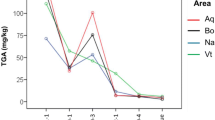Abstract
As part of an effort to study the relationship between the “glycoalkaloid trait” and genetic resistance to late blight (Phytophthora infestans), glycoalkaloid content in tuber and foliar tissues from a wide genetic background withinSolanum, includingS. demissum, S. iopetalum and 15 hybrids selected from a backcrossing breeding scheme was determined. Analysis of variance indicated significant genotypic effect on total glycoalkaloid, solanidine, α-solanine, and α-chaconine content in both tubers and leaves. Tubers from wild potato species commonly contain glycoalkaloids in concentrations that exceed international health regulations for human consumption (20 mg/100 g fresh weight). In this study,S. demissum andS. iopetalum were highest in total tuber glycoalkaloids among all materials tested, with 70.4 and 76.2 mg/100 g fresh weight, respectively. In contrast, both commercial cultivars had the lowest concentration, both below the safety limit. Solanine was more abundant than chaconine in all but one genotype. All hybrids were intermediate to low in total glycoalkaloids. Except for the two wild species, glycoalkaloid concentration in leaves of all genotypes studied was at least twice that in tubers, with glycosylated forms accounting for more than 80% total glycoalkaloid content. Correlation between tuber and foliage alkaloids was poor. In view of the observed field resistance to late blight, it was concluded that tuber glycoalkaloid content may not be responsible for such resistance.
Similar content being viewed by others
Abbreviations
- TGA:
-
total glycoalkaloids
- TLC:
-
thin layer chromatography
- RC:
-
backcrossing cycles
Literature Cited
Allen, E.H. and J. Kuc. 1968. α-Solanine and a-chaconine as fungitoxic compounds in extracts of Irish potato tubers. Phytopath 58:776–781.
Coria, N.A., J.I. Sarquís, I. Peñalosa, and M. Urzua. 1998. Heat-induced damage in potato (Solanum tuberosum) tubers: membrane stability, tissue viability and accumulation of glycoalkaloids. J Agric Food Chem 46:4524–4528.
Dale, M.F.B., D.W. Griffiths, H. Bain, and D. Todd. 1993. Glycoalkaloid increase inSolanum tuberosum on exposure to light. Ann Appl Biol 123:411–418.
Deahl, K.L., W.W. Cantelo, S.L. Sinden, and L.L. Sanford. 1991. The effect of light intensity on Colorado potato beetle resistance and foliar glycoalkaloid concentration of fourSolanum chacoense clones. Am Potato J 68:659–666.
Fewell, A.M. and J.G. Roddick. 1993. Interactive antifungal activity of the glycoalkaloids α-solanine and a-chaconine. Phytochem 33:323–328.
Friedman, M. and G.M. McDonald. 1997. Potato glycoalkaloids: Chemestry, analysis, safety and plant physiology. Crit Rev Plant Sci 16:55–132.
Gregory, P. 1984. Glycoalkaloid composition of potatoes: diversity and biological implications. Am Potato J 61:115–122.
Jadhav, S.J. and D.K. Salunkhe. 1975. Formation and control of chlorophyll and glycoalkaloids in tubers ofSolanum tuberosum L., and evaluation of glycoalkaloid toxicity. Adv Food Res 21:307–354.
Maga, J. 1980. Potato glycoalkaloids. Crit Rev Food Sci Nutr 12:371–405.
Moore, L.D. and D.M. Orcutt. 1982. Free sterol and total lipids in stems and resistant tobacco cultivars colonized byPhytophthora parasitica var. nicotianae. Physiol Biochem 72:1048–1051.
Morris, S.C. and T.H. Lee. 1984. The toxicity and teratogenicity of Solanaceae glycoalkaloids, particularly those of the potato (Solanum tuberosum). Food Tech Australia 36:118–124.
Olsson, K. 1987. The influence of glycoalkaloids and impact damage on resistance toFusarium solani var. coereruleum andPhoma exigua var. foveata in potato tubers. J Phytopathol 118:347–357.
Phillips, B.J., J.A. Hughes, J.C. Phillips, D.G. Walters, D. Anderson, and C.S.M. Tahourdin. 1996. A study of the toxic hazard that might be associated with the consumption of green potato tops. Food Chem Toxicol 34:439–448.
Sanford, L.L. and S.L. Sinden. 1972. Inheritance of potato glycoalkaloids. Am Potato J 49:209–217.
Shih, M. and J. Kuc. 1973. Incorporation of14C from acetate and mevalonate into Rishitin and steroid glycoalkaloids by potato tubers slices inoculated withPhytophttiora infestans. Phytopath 63:826–829.
Sinden, S.L., L.L. Sanford, and R.E. Webb. 1984. Genetic and environmental control of potato glycoalkaloids. Am Potato J 61:141–156.
Sinden, S.L. 1987. Potato glycoalkaloids. Hort Food Crops 207:41–47.
Stapleton, A., P.V. Allen, M. Friedman, and W.R. Belknap. 1991. Purification and characterization of solanidine glucosyltransferase from the potato (Solanum tuberosum). J Agric Food Chem 39:1187–1203.
van Gelder, W.M.J. 1990. Chemestry, toxicology and occurrence of steroidal glycoalkaloids: potential contaminants of the potato (Solanum tuberosum, L.).In: Rizk, A.M. (ed) Poisonous Plants Contaminating Edible Plants. CRC Press, Boca Raton, FL. pp 117–156.
van Gelder, W.M.J. and J.J.C. Scheffer. 1991. Transmission of steroidal glycoalkaloids fromSolanum vernei to the cultivated potato. Phytochem 30:165–168.
Woolfe, J.A. 1987. The Potato in the Human Diet. Cambridge University Press. Cambridge, England.
Author information
Authors and Affiliations
Corresponding author
Rights and permissions
About this article
Cite this article
Sarquís, J.I., Coria, N.A., Aguilar, I. et al. Glycoalkaloid content inSolanum species and hybrids from a breeding program for resistance to late blight (Phytophthora infestans). Am. J. Pot Res 77, 295–302 (2000). https://doi.org/10.1007/BF02853950
Accepted:
Issue Date:
DOI: https://doi.org/10.1007/BF02853950




